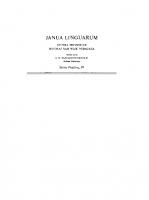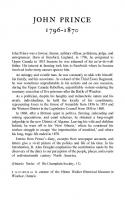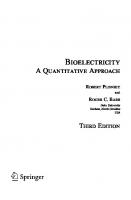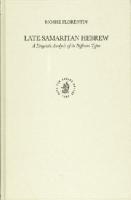A linguistic analysis of a collection of late Latin documents composed in Ravenna between A. D. 445-700: A quantitative approach [Reprint 2017 ed.] 311125402X, 9783111254029
193 57 26MB
English Pages 284 [285] Year 2017
ACKNOWLEDGEMENTS
FOREWORD
CONTENTS
SYMBOLS AND ABBREVIATIONS
1. INTRODUCTION
2. PHONOLOGY: VOCALIC
3. PHONOLOGY:CONSONANTS
4. PHONOLOGY: SPORADIC CHANGE
5. CONCLUSIONS
BIBLIOGRAPHY
WORD LIST
INDEX
Recommend Papers
![A linguistic analysis of a collection of late Latin documents composed in Ravenna between A. D. 445-700: A quantitative approach [Reprint 2017 ed.]
311125402X, 9783111254029](https://ebin.pub/img/200x200/a-linguistic-analysis-of-a-collection-of-late-latin-documents-composed-in-ravenna-between-a-d-445-700-a-quantitative-approach-reprint-2017nbsped-311125402x-9783111254029.jpg)
- Author / Uploaded
- Charles Merritt Carlton
File loading please wait...
Citation preview
JANUA LINGUARUM STUDIA MEMORIAE N I C O L A I VAN WIJK DEDICATA edenda curat C. H. VAN S C H O O N E V E L D Indiana University
Series Practica,
89
A LINGUISTIC ANALYSIS OF A COLLECTION OF LATE LATIN DOCUMENTS COMPOSED IN RAVENNA BETWEEN A.D. 445-700 A Quantitative
Approach
by
CHARLES M E R R I T T CARLTON University of Rochester
1973
MOUTON THE HAGUE • PARIS
(§) Copyright 1973 in The Netherlands. Mouton & Co. N.V., Publishers, The Hague No part of this book may be translated or reproduced in any form, by print, photoprint, microfilm, or any other means, without written permission front the publishers
LIBRARY OF CONGRESS CATALOG CARD NUMBER: 72-91400
Printed in Hungary
For David, John and Stephen
ACKNOWLEDGEMENTS
1 am deeply appreciative to numerous individuals whose special knowledge, guidance and counsel attended the development and completion, not only of the original dissertation on which this work is based, but also of this expanded version, in which I have endeavoured to deal - with the benefit of hindsight - more comprehensively with a limited segment. To R. L. Politzer, whose steps I have tried to follow and who was head of my doc toral committee at Michigan, I owe a special debt, both for his directing me to a corpus appropriate for investigation, as well as for the continuing inspiration and the insights afforded by his two major works in the same field, and by a series of papers which continue to serve as methodological models. My personal indebtedness is reiterated to Ernst Pulgram, who generously gave of his time and knowledge, and who in the ensuing years has imparted his views to me on matters of detail which I had found particularly troublesome. To Professors Politzer and Pulgram, both of whom I had the good fortune of studying under, I express my admiration for their friendly and mutual impartiality in exposing, with equal fervor and persuasiveness, two stances on the Vulgar Latin 'question' which diifer almost totally, at least with respect to the attitude toward the value of texts and the chronology. To others at a variety of institutions, I also express thanks: W. Seaman (Michigan State) for his special knowledge of Classical Latin; C. S. Leonard, Jr. (Michigan) for his elegant and eloquent expositions of the comparative method; D. Moutsos (Rochester) for his interest and critical insights. To H.-E. Keller (Ohio State) and U. T. Holmes, Jr. (North Carolina) I again express my thanks for their encouragement and assistance in my earlier work on the lexicon. Finally, I want to voice my affection for and my gratitude to D. L. Canfield, O. L. Chavarria-Aguilar, and R. Harrington, three chairmen, whose periods of stewardship of the Department of Languages and Linguistics at Rochester, so different in style and tone, have been alike in providing an atmosphere conducive to happy labor. Summer grants from the College of Arts and Sciences, University of Rochester, greatly facilitated my research.
FOREWORD
This study on Vulgar Latin and Romance is an expanded and heavily revised portion of a Ph.D. dissertation (University of Michigan, 1963). In composition and in conception, it preceded another portion of the same dissertation later published as Studies in Romance Lexicology (Chapel Hill, 1966).1 It was our thought at the time of the publication of the lexical study that it was precisely the vocabulary which afforded greatest interest, at least from the standpoint of the Romance languages.2 The findings of the remainder of the original thesis, which dealt with phonology, morphology and syntax, appeared to have relatively less significance. Part of this was probably due to the approach, which was largely a statistical tabulation of phenomena classed as strictly as possible under various categories in phonology, morphology, etc. To this end, models developed by R. L. Politzer3 were utilized and adhered to closely. But even in such forerunners as the Politzer works, it was recognized that the phenomena which best lent themselves to a statistical approach were those touching mainly on phonology, and to a lesser extent those which could be classed as morphological. It seemed justifiable therefore to reexamine our original work, restricting ourselves as fully as possible to phonology alone, indicating in the discussion and the notes areas where morphology or syntax impinges on the phonological development.4 The results of the original study on the phonology seemed quite unsatisfying, at least in comparison with the Politzer works which had apparently detected within VL data tendencies and computable trends which were at least partly predictive of dialectalization within the Romania. While it is arguable now whether the lexical findings - the most interesting ones of which occurred mainly in one document (8)s are intrinsically of greater interest, it does seem firmly established that the study of the phonology had yielded little in the phenomena themselves, or in the mass 1 2 3 4 6
University of North Carolina Studies in the Romance Languages and Literatures, no. 54. Cf. Preface of Carlton 1966, p. 7. Cf. 1.1, also footnote 6 below. E.g., {-urn} - (o), 2.317, 3.04; also verb forms in 2.211, 2.212, etc. Cf. Carlton 1966, 83, 84, 86-87, 90, 92, 95-96.
10
FOREWORD
of their occurrence, that might point definitively to, say, developments in Italian. Much of this had to do with purely mechanical factors, e.g., degree of preservation of our texts, uncertainty as to dates, etc. Nonetheless, the impression persisted that the corpus was extraordinarily conservative: the attempt to delineate trend lines, plotted against a lengthy time period (two and a half centuries) appeared to be disappointingly futile. Reexamination of the corpus and comparison with other studies, however, have placed these apparently unsatisfying results in quite another perspective. And while it cannot be stated with any certitude that we are any nearer to a determination of the exact date of dialectalization in the Romania, the evidence of the corpus might at least appear to support the thesis of Muller, Pei, etc., that dialectalization was in any event relatively late.6 The evidence of the study is this: from the multitude of changes, nothing significantly CONSISTENT could be ascertained with regard to the chronological development. This apparent perversity of the texts would indicate an extreme conservatism, almost conscious, on the part of the writers7 - or quite conceivably it reflects the fact that not all that much change had yet taken place.8 While we included in our earlier version isolated facts from other studies (Pei, Vielliard, etc.), mostly in support of our own findings, we have tried to broaden the scope of the work by looking more systematically and comprehensively at a representative sampling of other Vulgar Latin studies, from different areas in the Romania, from different time periods, and illustrating a variety of genres.9 Perhaps not surprisingly, we were struck by what appears to be a remarkably close correspondence among the various texts, whatever their external differences. Phenomena are much the same; aberrations - many of which never see the light of day in Romance - are strikingly similar in the different texts.10 Furthermore, some phenomena (e.g., prosthesis, cf. 4.21) which are indeed predictive of Romance developments are minimally attested. Most importantly, many of the phenomena in the different studies, despite variations in time and place of origin, are quantitatively very similar. To be sure, only in the Politzer works do we find absolutely quantified statements; nonetheless, fairly 6 Cf. H. F. Muller, "A Chronology of Vulgar Latin", in Zeitschrift fur Romartische Philologie, Beiheft 78 (1929); also M. A. Pei, The Italian Language, 2nd ed. (N.Y., 1954) pp. 12, 21-24, 26-27, The Language of the Eighth-Century Texts in Northern France (N.Y., 1932) pp. 3-4; also R. L. Politzer, A Study of the Language of Eighth Century Lombardic Documents (N.Y., 1949) pp. 1, 143; F. N. and R. L. Politzer, Romance Trends in 7th and 8th Century Latin Documents (Chapel Hill, 1953) p. 49, etc. On the general question of the dating of VL, as well as the various views on the break-up of the linguistic unity of the Romania, cf. Strecker 1957,29,30.11, and especially Gaeng 1968, 292-96 (cf. Chapter 1, Introduction, footnote 5). 7 Cp. Carlton 1966, 94-96. 8 Cf. review by M. A. Pei of R. Posner, The Romance Languages, in Modern Language Journal 51: 7 (Nov., 1967) pp. 424-426, especially p. 425. 9 Cf. 1.1, also Chapter 1, Introduction, footnote 5. 10 An especially noteworthy example is afforded by the fate of long accented /e/, whose spelling as (i) is explained variously (phonemic change, phonetic change, hypercorrection, etc.), differing according to locality and time, cf. 2.211, 2.24.
FOREWORD
11
clear notions of relative frequencies can be extrapolated from the prose descriptions of other scholars: the degree of uniformity is astonishingly high.11 Further bits of information are added to our original statement: e.g., Romance items whose development is apparently foreseen in our texts; also, notation of Italian forms which do NOT reflect the changes seen in the texts, as well as forms which appear in other VL collections.12 Mention is also made in the discussions of the relative chronology (in terms only of our collection) of forms which occur in both their CL and VL shapes. Finally, attention is called to certain of the problems to be taken into account in such studies, e.g., the multiplicity of rubrics under which a given feature is to be classed. To as great an extent as possible, we have attempted to give consideration to the roles played by certain and doubtful readings, the variations in the competence of the scribes, the interpretation of deviant spellings as indicators of true sound change or as hypercorrections, etc. This is facilitated by a network of cross-references, which will provide some sort of practical statement of the variables to be confronted by the future student of similar texts.
11
Comparison with other studies is of necessity based on a sampling (one which may in fact be too heavily weighted in favor of texts from Gaul); nonetheless it is our belief that some sort of law of diminishing returns is in effect here and that plotting of more and more texts would serve by and large to confirm the overall tendency toward textual uniformity in VL. 12 It is debatable whether phonological change should be so strictly associated with word-carriers; nonetheless the fact that much of the R o m a n c e lexicon is not directly derivable from either C L or written VL (cp. R . A. Hall, Jr., Introductory Linguistics [Philadelphia, 1964], p. 307, also Strecker 1957, 34 on Latin "heritage words" in Romance). Furthermore, our texts appear to point toward phenomena which are of relevance for the Romania, though not necessarily for Italian. Systematic inclusion of items which are actually attested in other VL collections, or which are reflected in later Romance forms, lends weight to the notion, which now appears supported by our statistical findings, that such collections do not really represent the language from which a specific variety of Romance may have sprung.
CONTENTS
Acknowledgements
7
Foreword
9
Symbols and Abbreviations
17
1. Introduction 1.1 Purpose 1.2 Description of Corpus 1.3 Specific Methodology
19 19 25 32
2. Phonology: Vocalic 2.1 Introduction 2.2 Vowels 2.21 Accented 2.211 Long/e/ 2.212 Short /i/ 2.213 Long /o/ 2.22 Remaining Accented Vowels 2.221 Long or Short /a/ 2.222 Short /e/ 2.223 Long /i/ 2.224 Short /o/ 2.225 Short /u/ 2.226 Long /u/ 2.23 Other Changes in Accented Position 2.24 Summary of the Accented Vowels 2.31 Unaccented 2.311 Short/e/ 2.312 Long /e/ 2.313 Short /i/ «i> ~ )
37 37 38 38 38 44 46 49 49 52 53 54 55 56 57 59 64 64 67 70
14
CONTENTS
2.32
2.33 2.34 2.41
2.42
2.43 2.44
2.314 Long /i/ 2.315 Short /o/ 2.316 Long /o/ 2.317 Short /u/ 2.318 Long /u/ Remaining Unaccented Vowels 2.321 Long or Short /a/ 2.322 fij and /e/ of Indeterminate Quantity or Quality 2.323 /uI and /o/ of Indeterminate Quantity or Quality 2.324 Syncope Other Changes in Unaccented Position Summary of the Unaccented Vowels Diphthongs 2.411 2.412 Short /e/ 2.413 Long /e/ Remaining Diphthongs 2.421 (au) 2.422 Other Changes in (ae> Summary of the Diphthongs
3. Phonology: Consonants 3.01 /b/ 3.011 Other Changes i n / b / 3.012 Summary 3.02 M 3.021 Summary 3.03 /h/Loss 3.031 /h/Addition of 3.032 Other Changes in /h/ 3.033 Summary 3.04 /m/ Loss 3.041 /m/ Addition of 3.042 Other Changes in /m/ 3.043 Summary 3.05 /k/ , /ks/ 3.051 Other Changes in /k/ 3.052 Summary 3.06 ft/ 3.061 Other Changes in /t/ 3.062 Summary
74 76 78 81 86 88 88 91 92 93 94 97 106 106 108 109 Ill Ill 113 114 117 119 119 122 123 124 127 127 130 132 134 135 139 142 143 144 146 148 149 152 153
CONTENTS
3.07 /p/ 3.08 /g/ 3.09 /d/ 3.091 Other Change in /d/ 3.092 Summary (3.07-3.09) 3.10 /s/ Loss 3.101 /s/Addition of (s) 3.102 Other Changes in /s/ 3.103 Summary 3.11 /n/Loss 3.111 /n/Addition of .88 The generally small number of changes in both short /e/ and /o/ in our texts is borne out by other studies (Chapter 2, Phonology : Vocalic, footnotes 59, 63). From all appearances, both short high vowels, /if (2,212) and fuf (2.225), exhibit a limited tendency, in their respective representations




![A Collection of Latin Proverbs [1 ed.]
9781607246237, 1607246236](https://ebin.pub/img/200x200/a-collection-of-latin-proverbs-1nbsped-9781607246237-1607246236.jpg)




